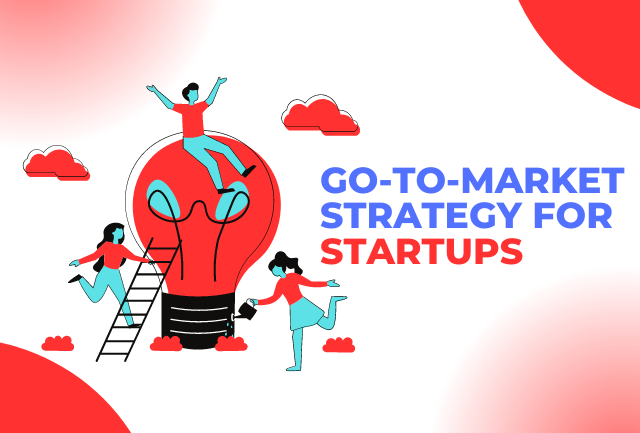Starting a business is really fun, but remember that around 90% of new businesses fail. This big failure rate often happens because there is not a good plan for entering and selling in markets.
In this article, we will look into the main things that new businesses need to do. We want a plan for how they start selling their product or service and make it win. This guide helps you succeed even if it seems hard at first!
What is an Early-Stage Startup?
Picture your startup like a little plant just coming out of the dirt. You’re in the early stages-a small team, not many resources and a lot of doubts. It’s like going through a new baby business startup. You improve your product, learn who you want it for and prepare to be noticed in the market. Investing in digital marketing services can help a great deal when it comes to this.
What is a Go-to-Market Strategy?
Now, let’s discuss the plan for selling – the Go-to-Market (GTM) strategy. Think of it as your company’s guide, explaining how you show the world what product or service you offer. This content marketing strategy includes things like price, where to sell and how to tell people about it. It helps you as a guide in the changing world of new businesses that are just starting up.
Benefits of Go-to-Market Strategy:
There are many reasons why you should look into implementing a go-to-market strategy. Let’s take a look at a few of the benefits you can expect:
- Stay on Target: Your GTM plan helps you stay on track in a wild market, guiding your work to where it’s most important.
- Speak Customer: By understanding your audience better, your strategy ensures that your products align with customer needs and preferences.
- Edge in the Game: Making a good GTM plan helps you stand out from others by carefully placing your product in the market.
Go-to-Market Strategy Framework:
When it comes to implementing any strategy, knowing where to start is important.
Here’s a look at a simple framework that can help guide your go-to-market strategy:
- Market Intel: Begin by knowing your target customers well, looking into their actions and changes in the market.
- Stand Out: Clearly define what makes your product unique, emphasizing its value proposition.
- Price it Right: Pick a way to set prices that shows the worth given, but also is good when compared with other things sold.
- Get Out There: Find the best ways to share your messages with the people you want to talk to.
- Shout It Loud: Make a big plan for advertising and selling, make sure your message is heard by the people you want.
Why Does an Early-Stage Startup Require a Go-to-Market Strategy?
Picture this: You don’t have many resources and you are going into something unknown. Now, envision having a hidden tool – a clear GTM plan. Here’s why it’s your startup’s ally:
- Smart Spending: Limited resources call for wise spending, and a GTM strategy helps you allocate resources where they will have the most impact.
- Risk Tamer: It reduces the scary risks associated with entering the market by providing a structured approach to market entry.
- Plan for Growth: Your GTM plan gets ready for big success, making sure your startup can deal with growth easily.
Developing Your Go-to-Market Strategy: A Step-by-Step Guide
Now, let’s start making your great GTM plan by following these steps. Follow this step-by-step guide:
1. Understand Your Target Market:
In order to successfully navigate the market, it’s important that you understand your target audience. Start by defining who your ideal customer is – maybe in demographics, psychographics’ and so forth. Also, practice market segmentation by splitting your audience into specific groups using the factors like industry, company size, geography or behavior and create strategies accordingly.
2. Define Your Value Proposition:
Your value proposition is the heart of why your product or service stands out among competitors. Define a specific Unique Selling Proposition USP that conveys the unique features or benefits of your offering. Identify particular benefits for end users.
3. Competitive Analysis:
You need to understand the competitive landscape in order to develop your approach towards a market. Start by identifying the direct and indirect competitors, then move on to a thorough SWOT analysis. Notify the strengths, weaknesses opportunities and threats to consider while making strategic decisions for your business and ensure that you become market strong.
4. Pricing Strategy:
Decide on a pricing scheme that matches your business objectives. Employ strategies like cost-plus, value based or competitive pricing. Set a base price based on production costs, what you might think has value to the consumer and potentially utilizing your competition’s pricing strategies in relation to his or her product worth within the market.
5. Distribution Channel Strategy:
Choosing the right channels for distribution will ensure that your product is easily passed on to your target audience. Choose the channels through which your product will be accessible like a direct sale, retailing or online. Find channel partnerships to fortify the distribution network and augment market reach.
6. Marketing Plan:
Develop a comprehensive marketing plan that will successfully position and promote your brand. Define clearly your brand positioning – who you want to be in the market. Develop a good marketing mix, focusing on the four Ps Product, Price, Place, and Promotion. Create a content strategy that will appeal to your target audience.
7. Sales Strategy:
Determining the best sales channels for your product is part of creating an effective sales strategy. Determine whether inside sales, field sales or online selling matches best with your product offering. Train your team on sales thoroughly, ensuring that they know how to sell the products successfully.
8. Launch Plan:
Product launch is a hard procedure that needs careful planning. These pre launch activities such as teasers and email campaigns should create anticipation. Organize and carry out the launch event to create some buzz or awareness, and capture your target’s attention before its introduction.
9. Customer Support and Success:
Create a strong customer support structure to address questions and complaints quickly. Make sure that onboarding and training programs are the priorities to guarantee customers have a good interaction with your product. Investing in customer success initiatives has a positive effect on long-term satisfaction and loyalty.
10. Metrics and Measurement:
Identify clear KPIs that will measure the success of your go-to-market plan. Establish feedback loops to capture insights from the customers, sales teams and other stakeholders.
11. Iterate and Adapt:
Adopt a continuous improvement culture by frequently evaluating the effectiveness of your go-to-market strategy. Adapt to feedback from markets, emerging patterns and changing circumstances. Adopt an agile process that will let your business make adjustments and iterate to remain competitive.
Tips for Successful Execution of Your Go-to-Market Strategy
The success of your GTM strategy lies in execution. Here are some practical tips:
- Flexibility is Key: Get ready to change and keep trying as you listen to what people think from the market.
- Team Talk: Help the marketing, sales and product development teams work together for a united plan.
- Talk to Your Fans: Set up a way to hear back from your customers so you can make your plan better using real info.
Examples Of Successful Go-To-Market Strategies
Let’s take a look at real-world examples where innovative Go-to-Market (GTM) strategies played a pivotal role in propelling startups to remarkable success:
1. Apple’s Hype Game: The iPhone Phenomenon
Apple, the tech giant renowned for its groundbreaking products, has consistently mastered the art of creating unparalleled anticipation and demand through strategic marketing buildup. One of the most notable instances is the launch of the iPhone series.
Details:
- Product Unveiling: Apple carefully plans product introductions, hinting at new features and improvements before the day of launch.
- Limited Availability: When new iPhones first come out, they are not easy to get. This makes people feel special and want them badly right away.
- Ecosystem Integration: Apple cleverly connects new iPhones with its already existing system. This makes using other Apple things easier and hard to resist for people who own them too.
- Brand Ambassadors: The company uses popular people, famous for their social media presence and press coverage to make more noise around it’s products. This creates interest and excitement in its offering.
Impact:
- Massive Sales: The mix of waiting for something and not much supply often causes high sales during the time when it first comes out.
- Brand Loyalty: Apple cultivates a loyal customer base eagerly awaiting each new product, establishing a strong brand affinity.
2. Slack’s Free Taste: Freemium Model Domination
Slack, a teamwork platform, got many people to use it by offering both free and paid ways. This let users try out the product first before they pay for it fully.
Details:
- Generous Free Tier: Slack gives a free version of its platform that works well. People can try it out without having to pay money first.
- User-Friendly Onboarding: The welcome process is made easy to understand and simple, making sure that new users feel comfortable from the start.
- Feature Teasers: Slack carefully adds extra features to the free version. This lets users try out special perks that come with a paid subscription.
- Team Collaboration: The website focuses on working together, telling people to bring in team members and feel the full use of Slack.
Impact:
-
Widespread Adoption: The pay-as-you-go system causes many people to use Slack. They like that it’s built into what they do every day at work.
Word of Mouth Growth: Happy free users become supporters, helping expansion by telling others about it.
Conversion Opportunities: Having extra features gives chances to change users into paying customers because they see the big value in a paid membership. These conversion optimization strategies are a game changer.
Most Common Go-To-Market Challenges and How to Overcome Them
Every journey comes with challenges. Here are common GTM challenges and how to tackle them:
- Budget Blues: Prioritize spending on high-impact marketing channels and activities.
- Stand Out: Clearly communicate your unique value proposition to avoid blending into the crowd.
- Ready to Grow: Plan for scalability in advance, ensuring your infrastructure can handle increased demand.
Takeaway Notes
As you navigate the world of startups, keep these key takeaways in mind:
- Step-by-Step Process: Building a GTM strategy is an iterative process that requires continuous refinement.
- Customer-Centric Approach: Be attentive to customer feedback, using it to adapt and improve your strategy.
- Team Collaboration: Effective teamwork across departments is pivotal for executing your GTM strategy successfully.




